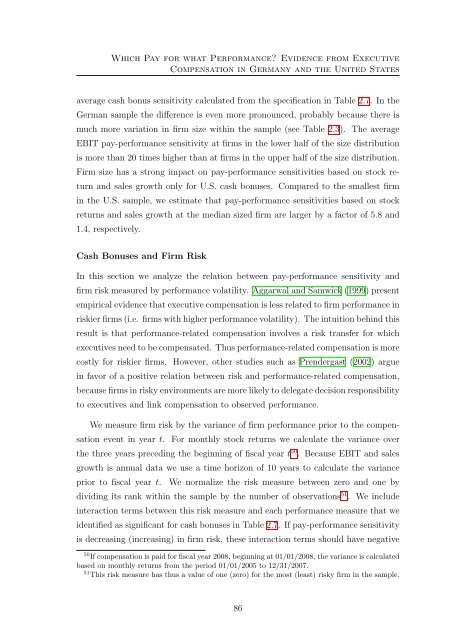Three Essays on Executive Compensation - KOPS - Universität ...
Three Essays on Executive Compensation - KOPS - Universität ...
Three Essays on Executive Compensation - KOPS - Universität ...
You also want an ePaper? Increase the reach of your titles
YUMPU automatically turns print PDFs into web optimized ePapers that Google loves.
Which Pay for what Performance? Evidence from <strong>Executive</strong><br />
Compensati<strong>on</strong> in Germany and the United States<br />
average cash b<strong>on</strong>us sensitivity calculated from the specificati<strong>on</strong> in Table 2.7. In the<br />
German sample the difference is even more pr<strong>on</strong>ounced, probably because there is<br />
much more variati<strong>on</strong> in firm size within the sample (see Table 2.3). The average<br />
EBIT pay-performance sensitivity at firms in the lower half of the size distributi<strong>on</strong><br />
is more than 20 times higher than at firms in the upper half of the size distributi<strong>on</strong>.<br />
Firm size has a str<strong>on</strong>g impact <strong>on</strong> pay-performance sensitivities based <strong>on</strong> stock return<br />
and sales growth <strong>on</strong>ly for U.S. cash b<strong>on</strong>uses. Compared to the smallest firm<br />
in the U.S. sample, we estimate that pay-performance sensitivities based <strong>on</strong> stock<br />
returns and sales growth at the median sized firm are larger by a factor of 5.8 and<br />
1.4, respectively.<br />
Cash B<strong>on</strong>uses and Firm Risk<br />
In this secti<strong>on</strong> we analyze the relati<strong>on</strong> between pay-performance sensitivity and<br />
firm risk measured by performance volatility. Aggarwal and Samwick (1999) present<br />
empirical evidence that executive compensati<strong>on</strong> is less related to firm performance in<br />
riskier firms (i.e. firms with higher performance volatility). The intuiti<strong>on</strong> behind this<br />
result is that performance-related compensati<strong>on</strong> involves a risk transfer for which<br />
executives need to be compensated. Thus performance-related compensati<strong>on</strong> is more<br />
costly for riskier firms. However, other studies such as Prendergast (2002) argue<br />
in favor of a positive relati<strong>on</strong> between risk and performance-related compensati<strong>on</strong>,<br />
because firms in risky envir<strong>on</strong>ments are more likely to delegate decisi<strong>on</strong> resp<strong>on</strong>sibility<br />
to executives and link compensati<strong>on</strong> to observed performance.<br />
We measure firm risk by the variance of firm performance prior to the compensati<strong>on</strong><br />
event in year t. For m<strong>on</strong>thly stock returns we calculate the variance over<br />
the three years preceding the beginning of fiscal year t 50 . Because EBIT and sales<br />
growth is annual data we use a time horiz<strong>on</strong> of 10 years to calculate the variance<br />
prior to fiscal year t.<br />
We normalize the risk measure between zero and <strong>on</strong>e by<br />
dividing its rank within the sample by the number of observati<strong>on</strong>s 51 . We include<br />
interacti<strong>on</strong> terms between this risk measure and each performance measure that we<br />
identified as significant for cash b<strong>on</strong>uses in Table 2.7. If pay-performance sensitivity<br />
is decreasing (increasing) in firm risk, these interacti<strong>on</strong> terms should have negative<br />
50 If compensati<strong>on</strong> is paid for fiscal year 2008, beginning at 01/01/2008, the variance is calculated<br />
based <strong>on</strong> m<strong>on</strong>thly returns from the period 01/01/2005 to 12/31/2007.<br />
51 This risk measure has thus a value of <strong>on</strong>e (zero) for the most (least) risky firm in the sample.<br />
86
















